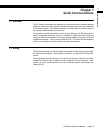
SC Series Instruction Manual page 49
Serial Communications7
7.4 Serial Com Menu
7.4.1 Overview
The Serial Com menu allows you to examine and change the settings for serial com-
munications as well as test the communications link.
Detailed instructions on operating the SC instrument in the SETUP Menu mode can
be found in “SETUP Menu mode” on page 23. A diagram of all menus is located in
“Setup Menu Reference” on page 157.
7.4.2
INTERFACE
Menu
Item
This menu item indicates which serial communications interface is installed in the
instrument: “
RS-232
” or “
RS-485
”.
7.4.3
ADDRESS
Menu
Item
This allows you to examine and change the two-character address that the instrument
will respond to. The default address of “00” (ASCII codes decimal 30, decimal 30).
7.4.4
BAUD RATE
Menu
Item
This allows you to examine and change the baud rate that the instrument uses for
serial communications. The default baud rate is 9600.
7.4.5
AUTO LINE-FEED
Menu Item
This allows you to examine the setting (on/off) of the auto line-feed function. When
set to “on”, a line-feed character (ASCII code decimal 10) is transmitted just before the
carriage return (ASCII code decimal 13) that signifies the end of the instrument’s
response.
If the instrument is connected to a dumb terminal or printer, inserting a line feed before
the carriage return will make each message sent by the instrument appear on a sepa-
rate line and thus be easier to read.
The default setting is “on”.
7.4.6
TRANSMIT TEST
Menu Item
When this menu item is selected, the instrument immediately transmits the message
“
ADDRESS nn TEST
” where “nn” is the two-character address of the instrument. Then the
message “
MESSAGE SENT
” is shown on the display. This helps detect wiring or other prob-
lems with serial communications from the instrument to the computer or PLC.
7.4.7
LEAVE MENU
Menu
Item
When the menu item is displayed, press [ENTER] to leave this menu. Press [EXIT] to
return to the RUN mode.


















